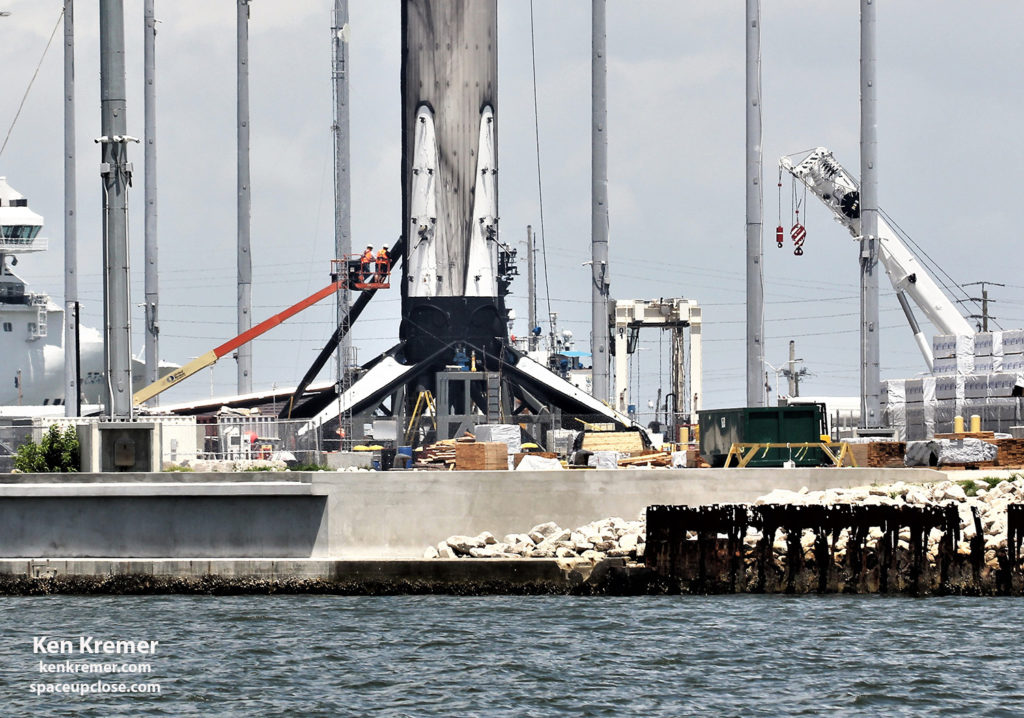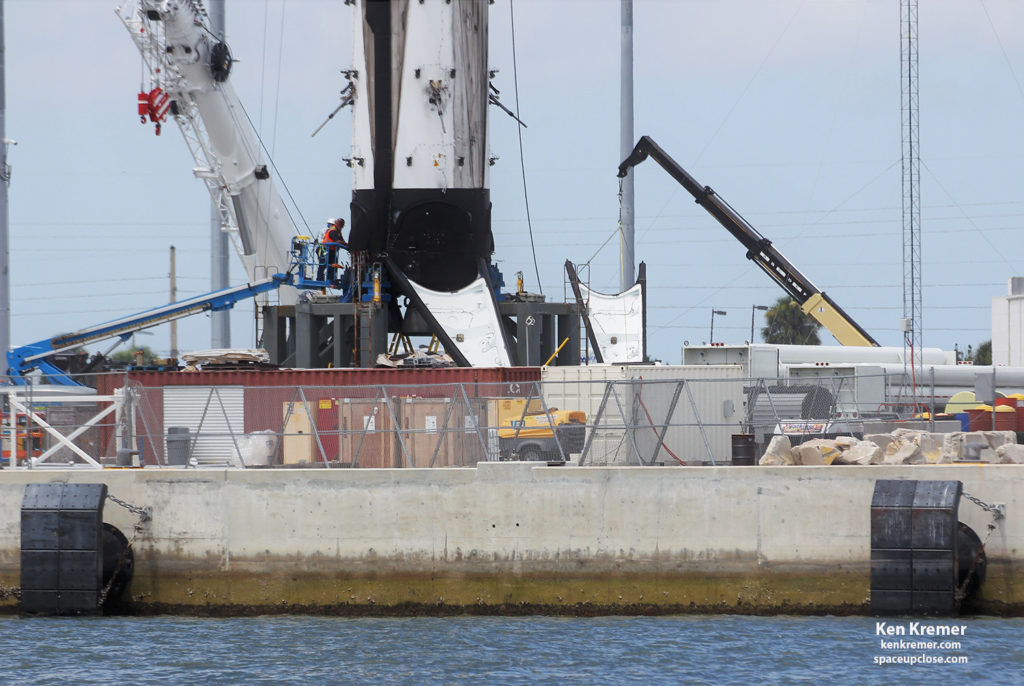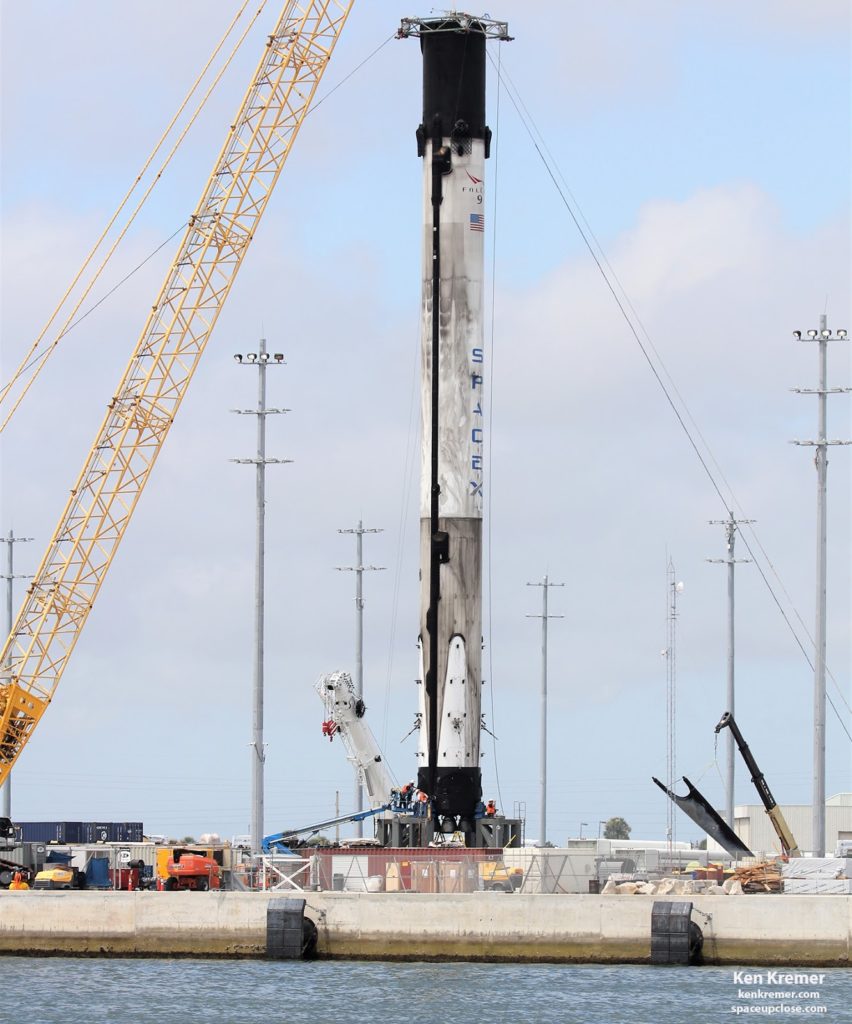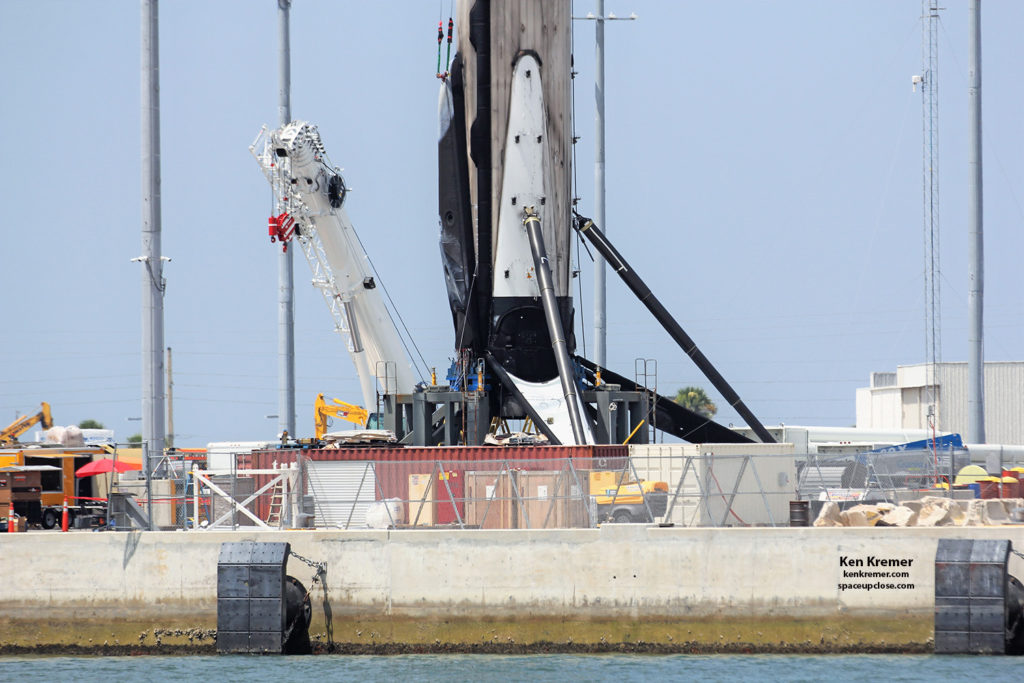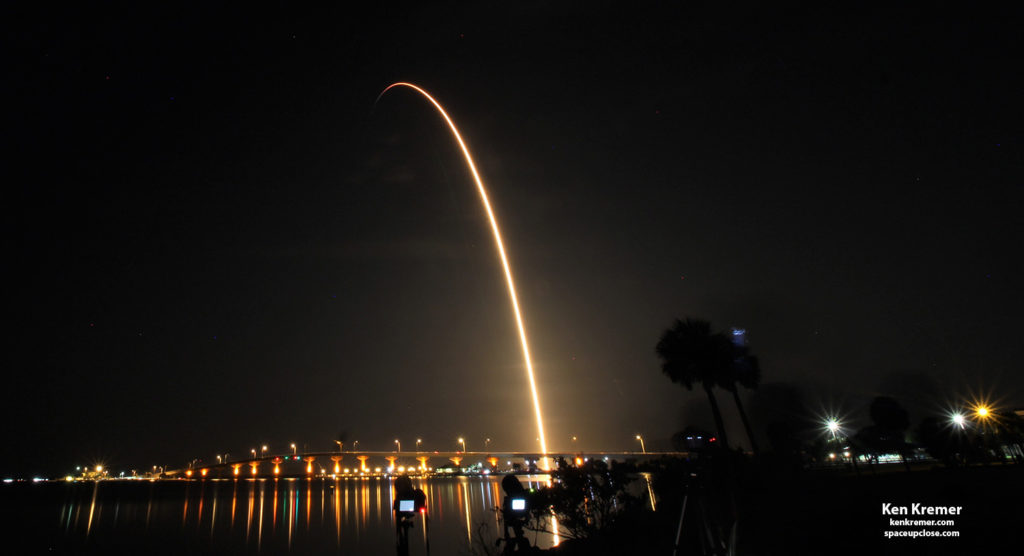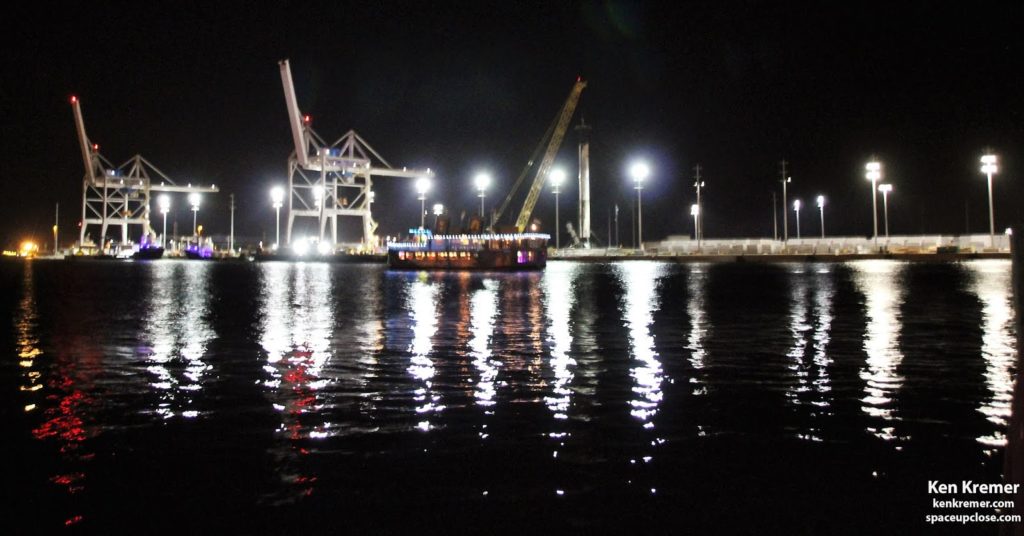— SpaceUpClose.com — 30 July 2018
PORT CANAVERAL, FL – Apparently SpaceX
has decided that dissection is the best course of action for now ! – regarding removal
of Falcon 9 landing legs from the firms recently Atlantic Ocean landed and upgraded
version of their 1st stage booster.
Thus – retractions of the four landing
legs post-landing up back against the core rather than complete removal appears
to be on hold for at least the time being for the Block 5 model Falcon 9!
That is despite the fact that SpaceX
technicians actually retracted a single leg from said booster into position facing
up and flush against the side of the core – as I witnessed with my own eyes Friday,
July 27, two days after it sailed into Port
Canaveral atop the dedicated OCISLY drone ship on July 25.
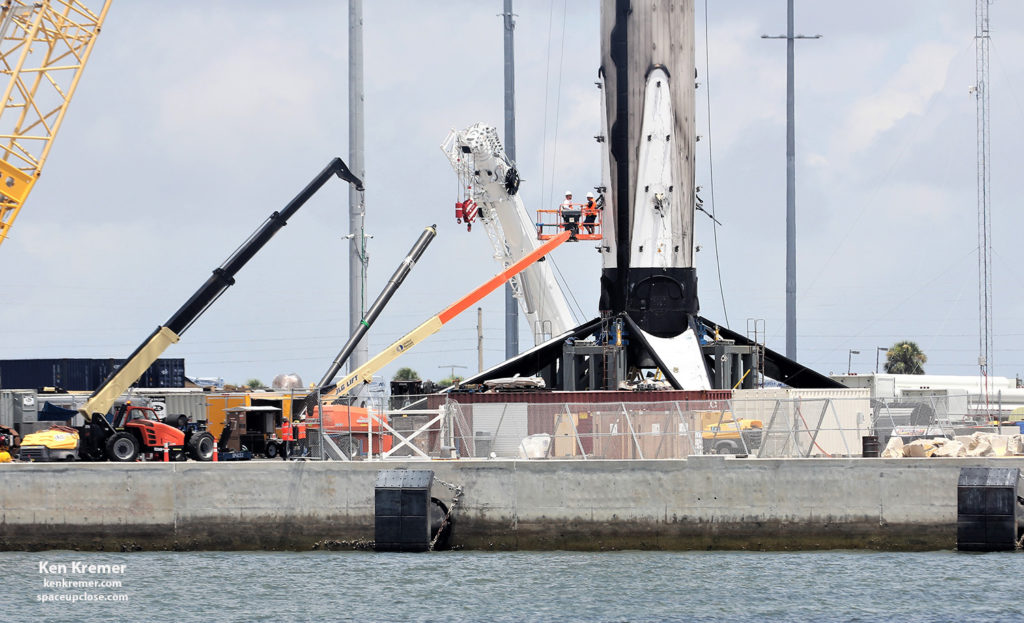 |
|
Removal
of last landing leg strut from recovered SpaceX Falcon 9 on July 28, 2018 after arrival back in Port Canaveral following Telstar19v launch. Credit: Ken Kremer/kenkremer.com/spaceupclose.com |
team lowered the retracted leg and essentially deployed it back to its original
landing position late Saturday evening, July 28 by 9 p.m. ET.
Then on Sunday afternoon, July 29, less
than 24 hours later, the team consisting of a few dozen workers, fell back on the
tried and true Block 4 method of leg removal – and methodically dissected off all
four legs by first unbolting and then detaching all four landing struts and pads one by one.
Check out my Space UpClose gallery
of eyewitness photos detailing the landing leg retraction, re-lowering and ultimately
dissection/detachment of all four legs.
Note: updating with additional photos and videos
slung on a harness and craned away. Then they set to work similarly on the
landing pads using an even larger harness and larger crane. The landing pad removal
procedure required about an hour and a half.
struts and pads took about three hours and appeared to go well – like clockwork.
retraction test involving the lone landing leg that I witnessed and reported on
last Friday on the booster recovered from the recent Telstar 19v telecommunications
satellite launch.
As to why SpaceX technicians
retracted one leg over a time span of about 40 minutes and that appeared to go
well – from my view across the channel of Port Canaveral – and then let moved it
back down to landed position – there is no answer at this time.
Perhaps the retraction was intended
as just a temporary test to work out procedures and kinks. Or perhaps something
went awry. No one knows.
It’s a mystery at this point.
Landing leg retraction was touted by
SpaceX CEO Elon Musk as a key improvement milestone for faster turnaround of ‘Flight-Proven’
first stages for the significantly
improved Block 5 version vs. the older and now retired Block 4 first stages.
In fact Musk said he aims for his
SpaceX team to launch, land and relaunch the same booster within a 24 hour period.
To accomplish that goal will require
rapid leg retraction rather than a 3 day long leg dissection process – among numerous
milestones to be safely and robustly achieved.
The used booster leg erection came
two full days after the 15-story tall first stage booster arrived in port at
sunrise Wednesday Morning.
The adventure began three days
earlier with the magnificent post-midnight liftoff of the massive 7.8 ton Telstar
19 VANTAGE (or Telstar 19v) Canadian
commercial telecommunications satellite atop the upgraded Falcon 9 taking place right
at the opening of the lengthy launch window at 1:50 a.m. EDT (0550 GMT) Sunday,
July 22 from seaside Space launch Complex-40
on Cape Canaveral Air Force Station, FL.
newly upgraded Block 5 version of the Falcon 9 first stage – that launched on
Sunday for only the second time.
easier to turnaround with minimal maintenance, says SpaceX CEO Elon Musk. His
goal is to relaunch a recovered Block 5 a second time within 24 hours by
sometime next year.
Overall Musk’s goal is to radically slash the cost of
building and launching rockets and enabling much cheaper access to space – with
airline like efficiencies for science, commercial enterprises and people.
airplanes.
the Falcon 9 booster which replaces the older, now discontinued Block 4.
Dragon CRS-15 resupply mission to the ISS.
was SpaceX’s 13th launch of the year.
24, a large broken off mangled piece of the payload fairing was hauled into
Port Canaveral on the GO Pursuit vessel.
retraction, booster arrival,
fairing arrival and launch articles and photos that accompany this story.
9 rocket successfully delivered the Telstar 19 VANTAGE comsat to a
geostationary transfer orbit (GTO) for Telesat, one of the world’s leading
commercial satellite operators.
Boeing, Lockheed Martin, Orbital ATK and more space and mission reports direct
from the Kennedy Space Center, Cape Canaveral Air Force Station, Florida and
Wallops Flight Facility, Virginia.
Stay tuned here for Ken’s continuing Earth and Planetary science and human spaceflight
news: www.kenkremer.com
–www.spaceupclose.com – twitter @ken_kremer – email: ken at kenkremer.com
SpaceX Merah Putih & Telstar 19 launches, NASA/ULA
Parker Solar Probe, SpaceX Falcon 9/CRS-15 launch to ISS, SES-12 comsat launch, Falcon Heavy, TESS, GOES-S, Bangabandhu-1,
NASA missions, ULA Atlas & Delta launches, SpySats and more at Ken’s
upcoming outreach events at Kennedy Space Center Quality Inn, Titusville, FL,
evenings:
4-6: “SpaceX Telstar 19 &
Merah Putih Launches, NASA/ULA Parker Solar Probe SpaceX Dragon CRS-15 resupply
launch to ISS, SpaceX Falcon Heavy & Falcon 9 launches, SpaceX SES-12
comsat. ULA Atlas USAF SBIRS GEO 4 missile warning satellite, SpaceX GovSat-1,
CRS-14 resupply launches to the ISS, NRO & USAF Spysats, SLS, Orion, Boeing
and SpaceX Commercial crew capsules, OSIRIS-Rex, Juno at Jupiter, InSight Mars
lander, Curiosity and Opportunity explore Mars, NH at Pluto and more,” Kennedy
Space Center Quality Inn, Titusville, FL, evenings.
Photos for sale



